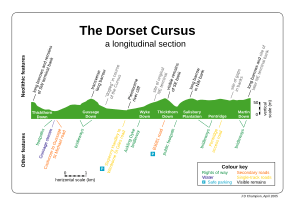Dorset Cursus facts for kids
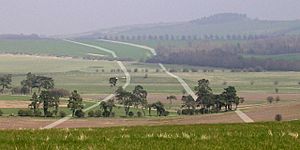
The Dorset Cursus is a Neolithic cursus monument that spans across 10 km (6¼ miles) of the chalk downland of Cranborne Chase in east Dorset, United Kingdom. Its extreme length makes it a notable example of this class of linear earthwork; it is better interpreted as a pair of same-length cursus constructed end to end, with the more southerly cursus (the Gussage Cursus) pre-dating the northerly one (the Pentridge Cursus).
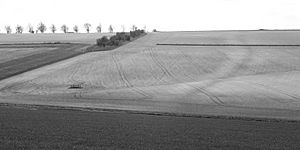
Context
Very little remains above ground of the Dorset Cursus, which once stretched for 10 km (6¼ miles) through the undulating chalkland of Cranborne Chase in east Dorset, from Martin Down to Thickthorn Down (both near the A354 road). It is by far the largest example of this class of ancient monument: it is over three times longer than the archetypical Great Cursus near Stonehenge. Most of the current knowledge about the course of this ancient earthwork comes from aerial photography (where its course can be seen as cropmarks or soilmarks) and other geophysical surveying techniques. However, there are a few locations (mentioned below) where the banks, much reduced in size, are still visible; the best-preserved earthworks are those of the southwestern terminal on Thickthorn Down .
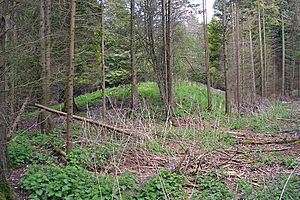
The Cursus dates from 3300 BCE which makes it contemporary with the earthen long barrows on Cranborne Chase: many of these are found near, on, or within the Cursus and since they are still in existence they help trace the Cursus' course in the modern landscape. The relationship between the Cursus and the alignment of these barrows suggests that they had a common ritual significance to the Neolithic people who spent an estimated 0.5 million worker-hours in its construction.
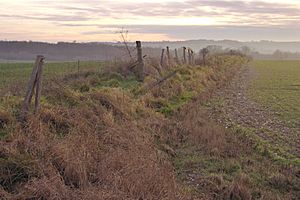
Physical details
The Cursus consisted of a pair of parallel banks (1.5 m tall) running about 82 m apart, with external ditches 1.5 m deep and 2 m wide. One bank is regular, whilst the other meanders, suggesting that the former was laid out first and the latter was dug using the former as a reference. The remains of these banks are still visible within Salisbury Plantation on Oakley Down, where a long barrow is built into the northwest bank . A 250 m length of the south-east bank remains on the northeast-facing slope of Bottlebush Down (, at right angles to the B3081 road). These banks were linked together by cross-banks at the terminals; of these only the southwestern terminal bank on Thickthorn Down remains , the north-eastern terminal on Martin Down has been removed by centuries of ploughing.
The overall orientation of the Cursus is northeast-southwest; it does not follow a perfectly straight line between its terminals, but consists of several straight sections (of varying lengths) with abrupt but small changes in direction. It is believed that the cursus was built in two separate phases. First the 5.6 km (3.5 mi) southwesterly section from Thickthorn Down to Bottlebush Down, sometimes referred to as the Gussage Cursus. This was later extended another 4.3 km (2.7 mi) northeast, from Bottlebush Down to the terminal on Martin Down.
The quasi-linear course of the Cursus means that it ignores topographical features of the landscape. It is by no means flat, and there is also no overall 'downhill' direction. In fact the vertical profile of the Gussage Cursus is quite symmetric: it has the ridge of Gussage Down in the middle, with river valleys on either side and the terminals near the summits of the neighbouring ridges. The later Pentridge Cursus has one steep valley crossing (between Bottlebush Down and Salisbury Plantation) and beyond that it stops traversing the contours and follows them instead, gently undulating its way towards the terminal on Martin Down.


